A Superfood disguised as a weed
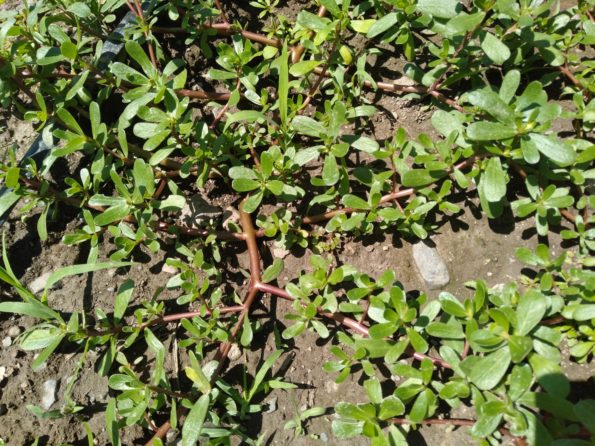 Purslane, Semizotu in Turkish, has been labeled a noxious weed in the United States, but it is also a highly nutritious vegetable which is widely eaten throughout Europe, Asia & the Middle East. It is a nutrient dense weed that thrives in harsh conditions like drought, in sidewalk cracks, and in salty or nutrient-deficient soil. Purslane is a succulent plant that is actually 93% water. It can be identified by it’s red stems and small green leaves. Purslane can be eaten raw in salads, stir-fried with other veggies or cooked in soups and stews. Some say that it tastes similar to watercress or that it has a tart almost lemony tang to it along with a peppery kick. In America this weed grows in abundance in my parents’ garden with relentless resilience. In Turkey, I pay to buy a bunch of fresh Purslane from the weekly Pazar. My favorite Turkish dish with Purslane, Semizotu Salatası, is a side salad or dip made with yogurt and dill which is just delicious! Recently, due to the abundance of Purslane available for free in the garden, flower beds, and just about anywhere I look, I have discovered several other nutritious and delicious recipes, such as: Purslane, Beef & Veggie Meal and Purslane Carrot Dip.
Purslane, Semizotu in Turkish, has been labeled a noxious weed in the United States, but it is also a highly nutritious vegetable which is widely eaten throughout Europe, Asia & the Middle East. It is a nutrient dense weed that thrives in harsh conditions like drought, in sidewalk cracks, and in salty or nutrient-deficient soil. Purslane is a succulent plant that is actually 93% water. It can be identified by it’s red stems and small green leaves. Purslane can be eaten raw in salads, stir-fried with other veggies or cooked in soups and stews. Some say that it tastes similar to watercress or that it has a tart almost lemony tang to it along with a peppery kick. In America this weed grows in abundance in my parents’ garden with relentless resilience. In Turkey, I pay to buy a bunch of fresh Purslane from the weekly Pazar. My favorite Turkish dish with Purslane, Semizotu Salatası, is a side salad or dip made with yogurt and dill which is just delicious! Recently, due to the abundance of Purslane available for free in the garden, flower beds, and just about anywhere I look, I have discovered several other nutritious and delicious recipes, such as: Purslane, Beef & Veggie Meal and Purslane Carrot Dip.
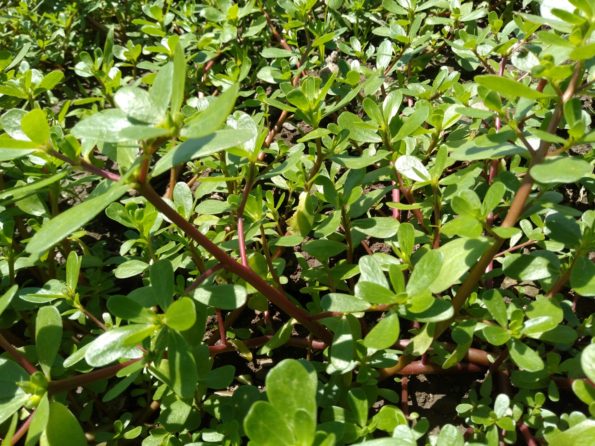 It is a shame that most people in the US don’t pick and eat Purslane thinking that it is simply an annoying and invasive weed when, in fact, it is one of the most nutrient-dense foods on the planet calorie for calorie! It has the highest level of Omega-3 fatty acids of any other green plant. Purslane, also known as “little hogweed,” is a superfood. A 3 ½ ounce serving (100 grams) of Purslane contains only 16 calories but is packed with vitamins, minerals and dietary fiber, such as:
It is a shame that most people in the US don’t pick and eat Purslane thinking that it is simply an annoying and invasive weed when, in fact, it is one of the most nutrient-dense foods on the planet calorie for calorie! It has the highest level of Omega-3 fatty acids of any other green plant. Purslane, also known as “little hogweed,” is a superfood. A 3 ½ ounce serving (100 grams) of Purslane contains only 16 calories but is packed with vitamins, minerals and dietary fiber, such as:
- 300-400 mg essential fatty acids
- 1350 IU Vitamin A (44%)
- 21 mg Vitamin C (35%)
- 68 mg Magnesium (17%)
- 494 mg Potassium (11%)
- 80 mg Calcium (8%)
- 2 mg Iron (25%)
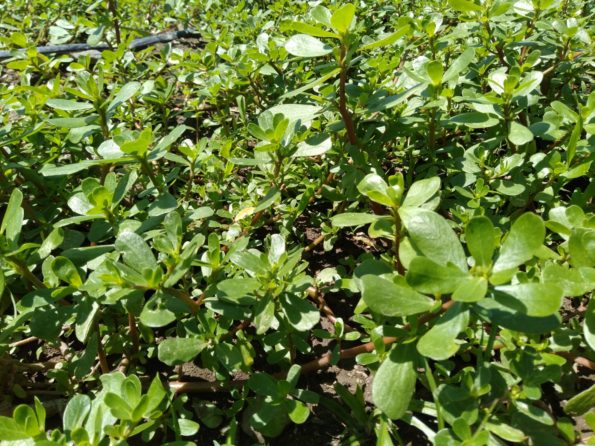 In China, Purslane is popular as a traditional medicine for treating hypotension and diabetes. It is also a very good source of Alpha-linolenic acid (an omega-3 fatty acid) which plays an important role in human growth, development, and preventing diseases such as stroke, ADHD, autism and other developmental differences in children. In Turkey, Purslane is considered a source of healing. Many recipes which include purslane are advertised with the word “şifa” right in the title indicating that this nutritious vegetable contains so much health it is sure to help whatever ails you. Mostly the green leaves are enjoyed, but the stems and flowers are edible as well.
In China, Purslane is popular as a traditional medicine for treating hypotension and diabetes. It is also a very good source of Alpha-linolenic acid (an omega-3 fatty acid) which plays an important role in human growth, development, and preventing diseases such as stroke, ADHD, autism and other developmental differences in children. In Turkey, Purslane is considered a source of healing. Many recipes which include purslane are advertised with the word “şifa” right in the title indicating that this nutritious vegetable contains so much health it is sure to help whatever ails you. Mostly the green leaves are enjoyed, but the stems and flowers are edible as well.
So whether you can walk outside and easily pick some fresh Purslane as you weed your garden or sidewalk, or you need to go the market and buy a fresh bunch, make sure to add some nutritious and delicious Purslane dishes to your menu planning this summer!
Semizotu Salatası
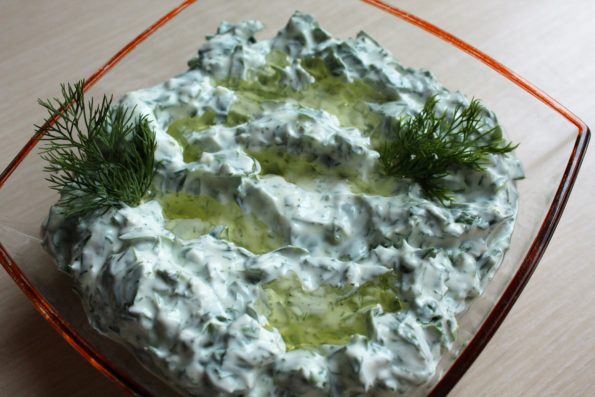
Purslane, Beef & Veggie Meal
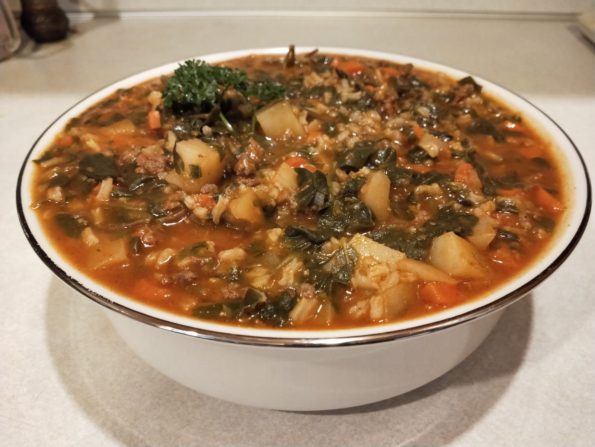
Purslane Carrot Dip
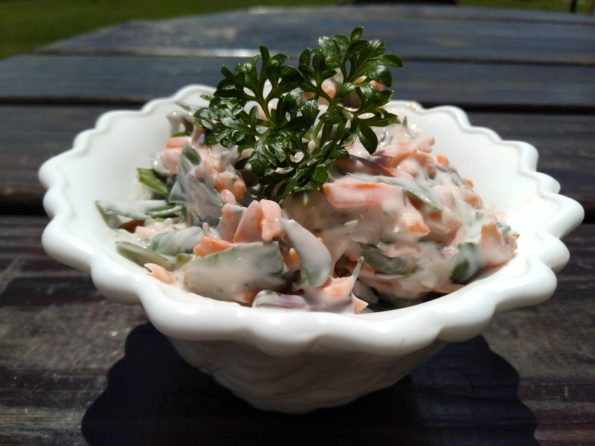



Deb Lapinski
I love your article, Jale! I am sooo glad to learn about how healthy Purslane is & to see your wonderful recipes.:) I have already tried all 3 of your recipes & enjoyed them all, but the semizotu salad is my favorite. It is easy to make & sooo delicious!!!
Wendy Zimmerman
Thank you for your insight into Purslane! I never knew this weed – that I hate – is actually a really good addition to our salads. My husband has been eating salads everyday for one meal and I now will be adding this to his and my plate. Thank you!
Jale
I am so glad the article was helpful. Happy and healthy eating! Or as we say in Turkish: afiyet olsun (bon apetit)